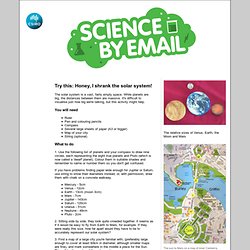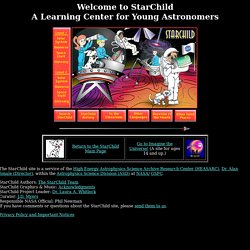

Science Based Activity - CSIRO. The solar system is a vast, fairly empty space.

While planets are big, the distances between them are massive. It's difficult to visualise just how big we're talking, but this activity might help. You will need Ruler Pen and colouring pencils Compass Several large sheets of paper (A3 or bigger) Map of your city String (optional) What to do 1. If you have problems finding paper wide enough for Jupiter or Saturn, use string to show their diameters instead, or, with permission, draw them with chalk on a concrete walkway. Interactives archive: Space. Anatomy of the RingsImages sent back from Cassini are resolving age-old mysteries about Saturn's rings.

Anatomy of a RoverExamine the robotic geologists and their scientific instruments. Asteroid That Hit L.A., TheA catastrophe calculator lets you try out some "what if" scenarios. Birth of a Black HoleIn this slide show, see how a dying star is reborn as a black hole. Birth of a SupernovaWhat exactly happens in a supernova explosion? See step-by-step the sequence of events that unfold during Type Ia and Type II supernovae. Blueprint for a Space StationWith animations and digital drawings, learn about key components of the ISS, from the Canadian-built robotic arm to the Japanese Experiment Module with its "back porch.
" Build a RocketLearn more about how the innovative German V-2 rocket worked by assembling it yourself. Catalogue of the CosmosExamine some of the universe's weirdest entities. Day In the Life, ALearn what it's like to be an astronaut aboard the Mir. Science / Social Studies / Solar system sensory globe- a fun project for kids. Neat! WorldWide Telescope. Phases of the Moon. Welcome to Universe Awareness. Solar System Passport. Here you can find a comprehensive archive of UNAWE and EU-UNAWE products, such as brochures and logos, as well as the source files (where available) so that they can be adapted and translated to suit your own requirements.

Our wide range of educational materials are available without charge (creative commons license) and you are also free to adapt these. Please take a few minutes to browse through the materials, and if you have a fantastic idea to supplement the existing educational resources, then we would love to hear from you! Send your ideas to info@unawe.org UNAWE and EU-UNAWE Resources are licensed under a Creative Commons Attribution-Non-Commercial-Share Alike 3.0 Unported License.
Mars rover Curiosity landing: Where to watch and what you’ll see - Ideas@Innovations. Posted at 12:49 PM ET, 08/03/2012 Aug 03, 2012 04:49 PM EDT TheWashingtonPost The Mars rover Curiosity is scheduled to land in the early morning hours of Monday, Aug. 6.

If you’re wondering just how big a deal the Curiosity mission is, The Post’s Marc Kaufman captures the significance and drama of the anticipated landing. First, the takeaway superlative for the landing: It “will be the most complex and hair-raising in planetary history.” Other superlatives include the fact that Curiosity is the largest and heaviest human-made object to land on Mars, a critical step if humans are ever to visit the planet. As you’ve probably gleaned by now, for NASA followers and fans, to say nothing of the casual observer, the mission is a must-see event.
NASA’s coverage of the event is scheduled to begin at 11:30 p.m. Patience may be the name of the game when it comes to photos and video, but it’s not for social media, on which NASA is very active. Yes, folks, this is that big of a deal. The Solar System Song. Phases of The Moon (Rock Version) Mr. Lee - Phases of the Moon rap. Electricity. Space & astronomy activities - CSIRO. PrimaryConnections. Moon phases diagram.
StarChild: A Learning Center for Young Astronomers. The StarChild site is a service of the High Energy Astrophysics Science Archive Research Center (HEASARC), Dr.

Alan Smale (Director), within the Astrophysics Science Division (ASD) at NASA/GSFC. StarChild Authors: The StarChild Team StarChild Graphics & Music: Acknowledgments StarChild Project Leader: Dr. Laura A. Whitlock Curator: Responsible NASA Official: If you have comments or questions about the StarChild site, please send them to us. Star Size Comparison HD. Engineering Interact - Interactive science & engineering for ...